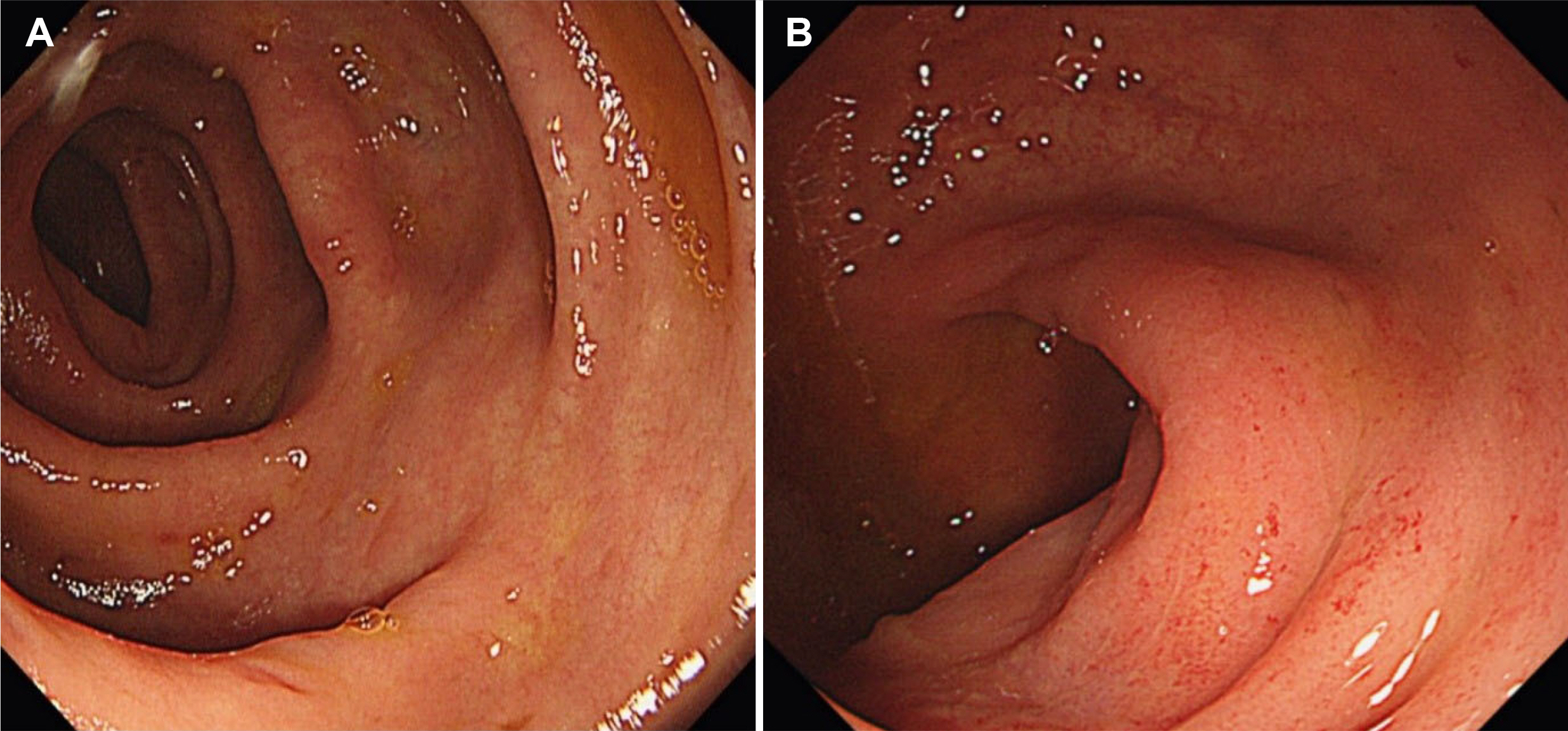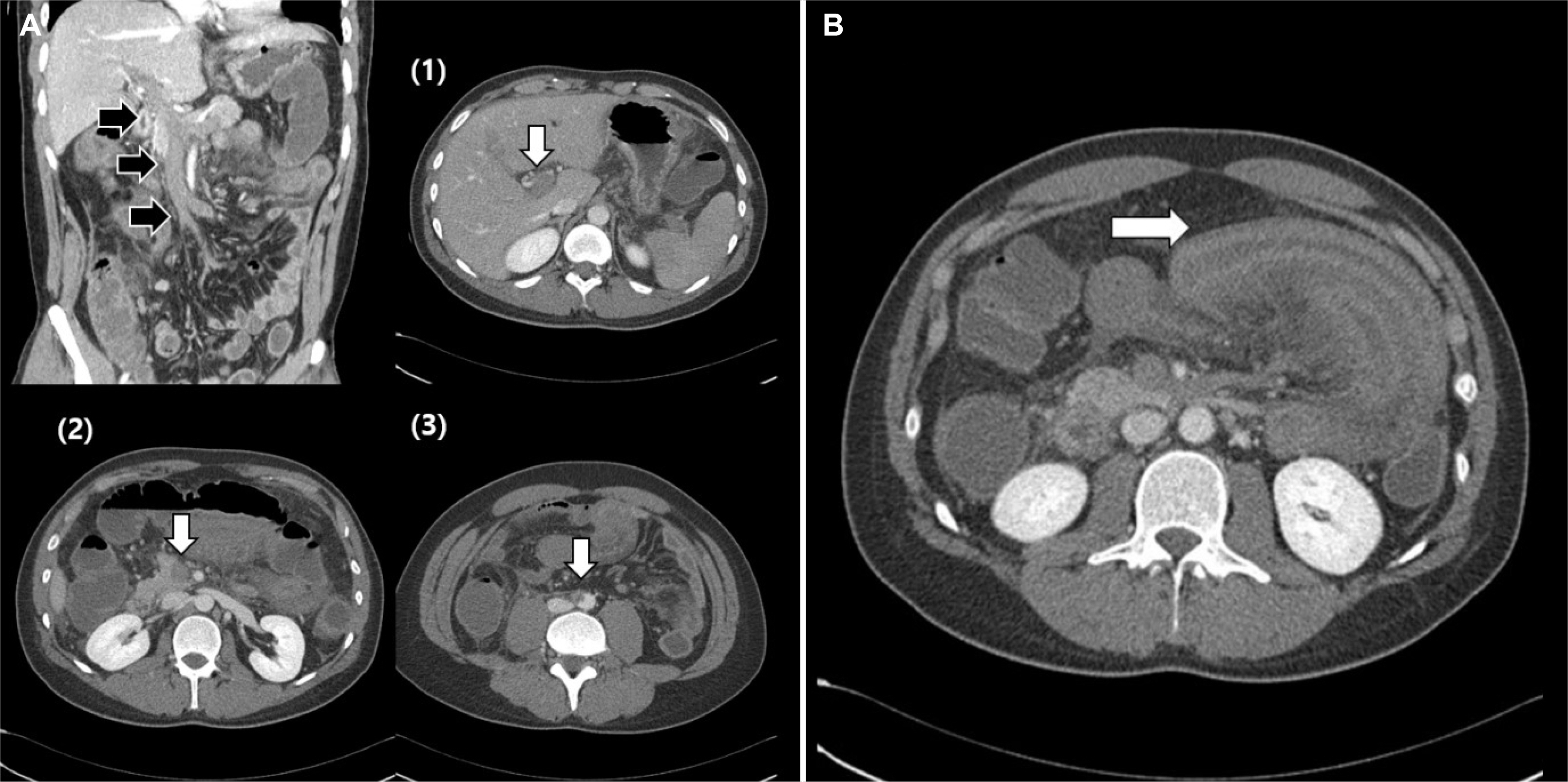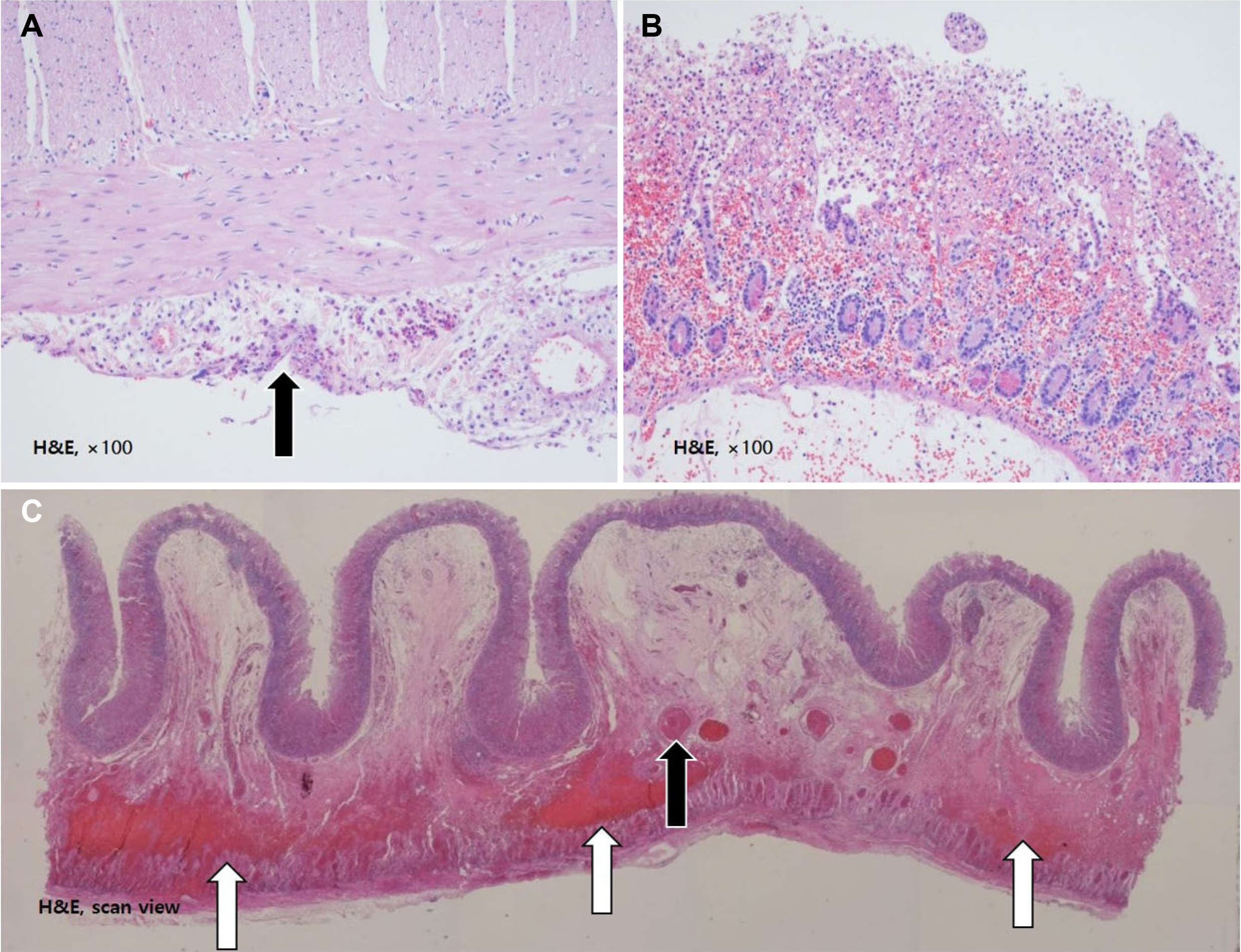Korean J Gastroenterol.
2021 Jun;77(6):294-299. 10.4166/kjg.2021.014.
Small Bowel Necrosis Associated with Catastrophic Antiphospholipid Syndrome: A Case Report
- Affiliations
-
- 1Department of Internal Medicine, Ewha Womans University, College of Medicine, Seoul, Korea
- KMID: 2516890
- DOI: http://doi.org/10.4166/kjg.2021.014
Abstract
- Catastrophic antiphospholipid syndrome is a highly fatal condition characterized by widespread thromboembolism subsequent to a triggering factor (e.g., infection, trauma, and neoplasia) in antiphospholipid antibody-positive patients. This paper reports a case of a 29-year-old male without the underlying disease who developed extensive mesenteric thromboembolism and jejunal necrosis during the treatment for acute enteritis. The patient’s condition was improved with low-molecular-weight heparin and an intravenous Ig treatment with emergency surgery. The serum antiphospholipid (anticardiolipin IgM) and lupus anticoagulant antibody tests showed positive results. Acute infectious enterocolitis is generally considered a mild disease. On the other hand, aggressive evaluation and treatment should be considered if the clinical conditions do not improve and deteriorate rapidly despite appropriate antibiotic treatment because of the possibility of acute immunological complications, such as catastrophic antiphospholipid syndrome.
Keyword
Figure
Reference
-
1. Andreoli L, Chighizola CB, Banzato A, Pons-Estel GJ, Ramire de Jesus G, Erkan D. 2013; Estimated frequency of antiphospholipid antibodies in patients with pregnancy morbidity, stroke, myocardial infarction, and deep vein thrombosis: a critical review of the literature. Arthritis Care Res (Hoboken). 65:1869–1873. DOI: 10.1002/acr.22066. PMID: 23861221.
Article2. Cervera R, Piette JC, Font J, et al. 2002; Antiphospholipid syndrome: clinical and immunologic manifestations and patterns of disease expression in a cohort of 1,000 patients. Arthritis Rheum. 46:1019–1027. DOI: 10.1002/art.10187. PMID: 11953980.
Article3. Bucciarelli S, Espinosa G, Cervera R, et al. 2006; Mortality in the catastrophic antiphospholipid syndrome: causes of death and prognostic factors in a series of 250 patients. Arthritis Rheum. 54:2568–2576. DOI: 10.1002/art.22018. PMID: 16868979.
Article4. Sciascia S, Lopez-Pedrera C, Roccatello D, Cuadrado MJ. 2012; Catastrophic antiphospholipid syndrome (CAPS). Best Pract Res Clin Rheumatol. 26:535–541. DOI: 10.1016/j.berh.2012.07.005. PMID: 23040365.
Article5. Carmi O, Berla M, Shoenfeld Y, Levy Y. 2017; Diagnosis and management of catastrophic antiphospholipid syndrome. Expert Rev Hematol. 10:365–374. DOI: 10.1080/17474086.2017.1300522. PMID: 28277850.
Article6. Levine JS, Branch DW, Rauch J. 2002; The antiphospholipid syndrome. N Engl J Med. 346:752–763. DOI: 10.1056/NEJMra002974. PMID: 11882732.
Article7. Bachmeyer C, Barrier A, Frazier A, et al. 2006; Diffuse large and small bowel necrosis in catastrophic antiphospholipid syndrome. Eur J Gastroenterol Hepatol. 18:1011–1014. DOI: 10.1097/01.meg.0000230085.45674.84. PMID: 16894316.
Article8. Klestzick HN, McPhedran P, Cipolla D, Berry WA, DiCorato M, Denowitz J. 1995; The antiphospholipid syndrome and ischemic colitis. Gastroenterologist. 3:249–256. PMID: 8535776.9. Jürgensen JS, Kettritz R, Schneider W, et al. 2003; Catastrophic antiphospholipid syndrome masquerading as ischaemic colitis. Rheumatol Int. 23:204–206. DOI: 10.1007/s00296-003-0296-1. PMID: 12679877.
Article10. Asherson RA, Cervera R, Piette JC, et al. 2001; Catastrophic antiphospholipid syndrome: clues to the pathogenesis from a series of 80 patients. Medicine (Baltimore). 80:355–377. DOI: 10.1097/00005792-200111000-00002. PMID: 11704713.11. Rodríguez-Pintó I, Moitinho M, Santacreu I, et al. 2016; Catastrophic antiphospholipid syndrome (CAPS): descriptive analysis of 500 patients from the International CAPS Registry. Autoimmun Rev. 15:1120–1124. DOI: 10.1016/j.autrev.2016.09.010. PMID: 27639837.
Article12. Aguiar CL, Erkan D. 2013; Catastrophic antiphospholipid syndrome: how to diagnose a rare but highly fatal disease. Ther Adv Musculoskelet Dis. 5:305–314. DOI: 10.1177/1759720X13502919. PMID: 24294304. PMCID: PMC3836378.
Article13. Uthman I, Khamashta M. 2007; The abdominal manifestations of the antiphospholipid syndrome. Rheumatology (Oxford). 46:1641–1647. DOI: 10.1093/rheumatology/kem158. PMID: 17636180.
Article14. Kalman DR, Khan A, Romain PL, Nompleggi DJ. 1996; Giant gastric ulceration associated with antiphospholipid antibody syndrome. Am J Gastroenterol. 91:1244–1247. PMID: 8651180.15. Russell CE, Wadhera RK, Piazza G. 2015; Mesenteric venous thrombosis. Circulation. 131:1599–1603. DOI: 10.1161/CIRCULATIONAHA.114.012871. PMID: 25940967.
Article16. Hughson MD, McCarty GA, Brumback RA. 1995; Spectrum of vascular pathology affecting patients with the antiphospholipid syndrome. Hum Pathol. 26:716–724. DOI: 10.1016/0046-8177(95)90218-X. PMID: 7628842.
Article17. Asherson RA, Cervera R, de Groot PG, et al. 2003; Catastrophic antiphospholipid syndrome: international consensus statement on classification criteria and treatment guidelines. Lupus. 12:530–534. DOI: 10.1191/0961203303lu394oa. PMID: 12892393.18. Chaturvedi S, Braunstein EM, Yuan X, et al. 2020; Complement activity and complement regulatory gene mutations are associated with thrombosis in APS and CAPS. Blood. 135:239–251. DOI: 10.1182/blood.2019003863. PMID: 31812994. PMCID: PMC6978159.
Article19. Skoczynska M, Crowther MA, Chowaniec M, Ponikowska M, Chaturvedi S, Legault K. 2020; Thrombotic microangiopathy in the course of catastrophic antiphospholipid syndrome successfully treated with eculizumab: case report and systematic review of the literature. Lupus. 29:631–639. DOI: 10.1177/0961203320917460. PMID: 32252584.
Article20. Legault K, Schunemann H, Hillis C, et al. 2018; McMaster RARE-bestpractices clinical practice guideline on diagnosis and management of the catastrophic antiphospholipid syndrome. J Thromb Haemost. 16:1656–1664. DOI: 10.1111/jth.14192. PMID: 29978552.
Article
- Full Text Links
- Actions
-
Cited
- CITED
-
- Close
- Share
- Similar articles
-
- Catastrophic Primary Antiphospholipid Syndrome
- Catastrophic Antiphospholipid Syndrome Associated with Systemic Lupus Erythematosus Successfully Treated with Rituximab: A Case Report
- Catastrophic Antiphospholipid Syndrome Improved by Anticoagulation Alone
- Hepatic infarction in a pregnant woman with antiphospholipid syndrome and triple antibody positivity: A case report focusing on catastrophic antiphospholipid syndrome
- Outcome of Disseminated Intravascular Coagulation without Documented Antiphospholipid Antibody Successfully Treated with Rituximab





